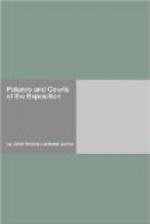Near by is Paul Manship’s “Music,” adding the song, and the music of the lyre.
As a last touch you will find the nations of the Occident and the nations of the Orient marching into this Court of the Universe to take part in the festival in celebration of one of the greatest events of history — the opening of the Panama Canal.
At night comes the illumination, as a climax to the festival, and gradually the lights die down and all is still — just for a few hours only, for day will dawn, for is not the Rising Sun ever with us — and another day of festivity will come, and yet more at this greatest festival that the world has ever known.
The Tower of Jewels
Architect — Thomas Hastings of New York.
Architecture — Italian Renaissance with Byzantine features.
This great Tower of Jewels symbolizes the Panama Canal, the jewel today that is most resplendent.
It is 433 feet high. In cold weather, owing to the contraction of the steel, it is said to be four inches shorter than in warm weather.
The arch is 110 feet high and 60 feet broad.
The tower is in seven lifts, surmounted by the earth with its shimmering jewels. You are reminded that the whole earth is affected by this stupendous piece of engineering (the Panama Canal).
The figures on the pedestals of the arch are by John Flanagan of New York, and they represent:
1. The Adventurer, the type of man of the 16th
century who pushed out
into the wilderness
of the southwest.
2. The Priest, the type of man who came to convert
the country in the
16th century.
3. The Philosopher, who by his fine knowledge
of the Greek and Latin
manuscripts was
able to disseminate knowledge in the 16th century
thruout the new
regions.
4. The Warrior, the type of 16th century soldier
who came to conquer the
country.
On the first tier you meet the Armoured Horseman by Tonetti, the type of colonizer of the 16th century.
Now look at the equestrian statues that stand on either side of the Tower. That on the right is Cortez (by Chas. Niehaus), the conqueror of Mexico — the man who wrested Mexico from Montezuma for the kingdom of Spain.
On the left Pizarro (by Chas. Rumsey), the conqueror of Peru, who gained for Spain the land of the Incas.
The country north of the Panama region was conquered by the Spanish. That on the south of Panama was also the Spanish land.
It is time now to read the inscriptions on the south side of the tower:
1501
Rodrigo de Bastides, pursuing his course beyond the West Indies, discovers Panama.
1513
Vasco Nuñez de Balboa, crossing the Isthmus of Panama,
discovers the
Pacific Ocean.
1904
The United States, succeeding France, begins operations
on the Panama
Canal.




